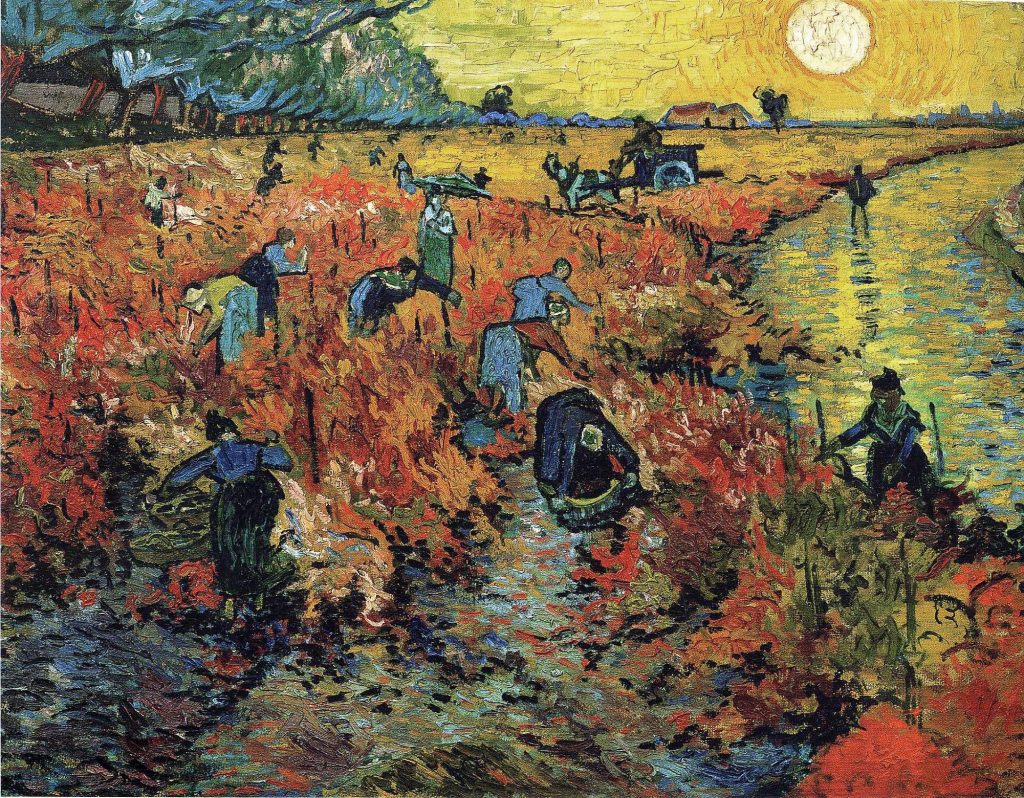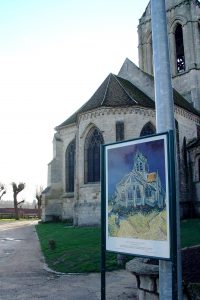Immersed in Van Gogh
Delegates to EURETINA and ESCRS meetings in Paris can enjoy all things Van Gogh

Maryalicia Post
Published: Saturday, June 1, 2019
 Red Vineyard at Arles[/caption]
The chance to view Vincent van Gogh’s paintings transformed into an ‘immersive exhibition’ has proven to be an outstanding attraction in Paris. Running at the Atelier des Lumières until 22 December 2019, La Nuit Etoilée is a 35-minute light and sound show, an intimate exploration of Van Gogh’s paintings and the environments in which they were created. www.sortiraparis.com
This immersive concept has been hailed as ‘thrilling’ and a ‘must see’, but you can treat yourself to an immersive experience of a different kind in the village of Auvers-sur-Oise, only 35 kilometres from Paris. Here, signs posted along the country roads indicate the vantage points from which Van Gogh painted 12 of his famous works. Stand in the room at Auberge Ravoux (closed Monday and Tuesday) in which the painter lived for 70 days – and in which he died. A short walk away, see the field that was the subject of the painter’s last work. Next to it is the graveyard where ivy-clad headstones mark the final resting places of Van Gogh and his ever-supportive brother Theo.
(Read Van Gogh’s correspondence with his brother, Gauguin and others here in Dutch with English translation.)
At the Auvers Tourist Bureau watch a moving video of the artist’s time in the town and pick up maps tracing Van Gogh’s footsteps. Visit the house of his physician, Dr Paul Gachet, and perhaps the 17th-Century Chateau d’Auvers; it was in its grounds that the destitute, 37-year-old Vincent fired the fatal bullet into his abdomen. He would die two days later in Chambre 5 of the Auberge Ravoux, attended by his brother and Dr Gachet.
Book a meal at the Auberge, now a restaurant called ‘La Maison de Van Gogh’. The room, in which Van Gogh had a table at the back, retains the atmosphere of a simple inn but the food is decidedly more sophisticated. There’s a small book and gift shop. www.maisondevangogh.fr
Auvers is a 35-minute drive from Palais des Congrès or an hour from Paris Expo; you can do it in a day but better still, stay overnight in the eight-room Hotel des Iris across from the Maison de Van Gogh. info@hoteldesiris.com. Or choose a b&b from the list on the tourist office website: www.tourisme-auverssuroise.fr. Then, early next morning, see the village almost on your own… just you looking through the eyes of Van Gogh, walking where he walked, seeing what he saw. As an immersive experience, it’s hard to beat.
Red Vineyard at Arles[/caption]
The chance to view Vincent van Gogh’s paintings transformed into an ‘immersive exhibition’ has proven to be an outstanding attraction in Paris. Running at the Atelier des Lumières until 22 December 2019, La Nuit Etoilée is a 35-minute light and sound show, an intimate exploration of Van Gogh’s paintings and the environments in which they were created. www.sortiraparis.com
This immersive concept has been hailed as ‘thrilling’ and a ‘must see’, but you can treat yourself to an immersive experience of a different kind in the village of Auvers-sur-Oise, only 35 kilometres from Paris. Here, signs posted along the country roads indicate the vantage points from which Van Gogh painted 12 of his famous works. Stand in the room at Auberge Ravoux (closed Monday and Tuesday) in which the painter lived for 70 days – and in which he died. A short walk away, see the field that was the subject of the painter’s last work. Next to it is the graveyard where ivy-clad headstones mark the final resting places of Van Gogh and his ever-supportive brother Theo.
(Read Van Gogh’s correspondence with his brother, Gauguin and others here in Dutch with English translation.)
At the Auvers Tourist Bureau watch a moving video of the artist’s time in the town and pick up maps tracing Van Gogh’s footsteps. Visit the house of his physician, Dr Paul Gachet, and perhaps the 17th-Century Chateau d’Auvers; it was in its grounds that the destitute, 37-year-old Vincent fired the fatal bullet into his abdomen. He would die two days later in Chambre 5 of the Auberge Ravoux, attended by his brother and Dr Gachet.
Book a meal at the Auberge, now a restaurant called ‘La Maison de Van Gogh’. The room, in which Van Gogh had a table at the back, retains the atmosphere of a simple inn but the food is decidedly more sophisticated. There’s a small book and gift shop. www.maisondevangogh.fr
Auvers is a 35-minute drive from Palais des Congrès or an hour from Paris Expo; you can do it in a day but better still, stay overnight in the eight-room Hotel des Iris across from the Maison de Van Gogh. info@hoteldesiris.com. Or choose a b&b from the list on the tourist office website: www.tourisme-auverssuroise.fr. Then, early next morning, see the village almost on your own… just you looking through the eyes of Van Gogh, walking where he walked, seeing what he saw. As an immersive experience, it’s hard to beat.
3 to sample
 The Church at Auvers
The Church at Auvers